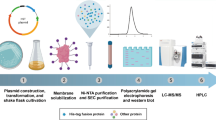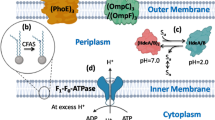Abstract
Molybdenum is required for induction of nitrate reductase and of NAD-linked formate dehydrogenase activities in suspensions of wild type Paracoccus denitrificans; tungsten prevents the development of these enzyme activities. The wild type forms a membrane protein M r150,000 when incubated with tungsten and inducers of nitrate reductase and this is presumed to represent an inactive form of the enzyme. Suspensions of mutant M-1 did not develop nitrate reductase or formate dehydrogenase activities but the membrane protein M r150,000 was formed under all conditions tested, including without inducers and without molybdenum. Analysis of membranes, solubilized with deoxycholate, by polyacrylamide gel electrophoresis under nondenaturing conditions showed that the mutant protein had similar electrophoretic mobility to the active nitrate reductase formed by the wilde type. Autoradiography of preparations from cells incubated with 55Fe showed that the mutant and wild type proteins contained iron. However, in similar experiments with 99Mo, incorporation of molybdenum into the mutant protein was not detectable.
We conclude that mutant M-1 is defective in one or more steps required to process molybdenum for incorporation into molybdoenzymes. This failure affects the normal regulation of nitrate reductase protein with respect to the role of inducers.
Similar content being viewed by others
Abbreviations
- DOC:
-
deoxycholate
- PAGE:
-
polyacrylamide gel electrophoresis
- SDS:
-
sodium dodecyl sulfate
References
Bamforth, C. W., Quayle, J. R.: Aerobic and anaerobic growth of paracoccus denitrificans on methanol. Arch. Microbiol. 119, 91–97 (1978)
Bonner, W. M., Laskey, R. A.: A film detection method for tritiumlabelled protein and nucleic acids in polyacrylamide gels. Eur. J. Biochem. 46, 83–88 (1974)
Burke, K. A., Lascelles, J.: Nitrate reductase system in Staphylococcus aureus wild type and mutants. J. Bacteriol. 123, 308–316 (1975)
Calder, K., Burke, K.A., Lascelles, J.: Induction of nitrate reductase and membrane cytochromes in wild type and chlorate-resistant Paracoccus denitrificans (Submitted)
Cox, R. B., Quayle, J. R.: The autotrophic growth of Micrococcus denitrificans on methanol. Biochem. J. 150, 569–571 (1975)
Dulley, J. R., Greene, P. A.: A simple technique for eliminating interference by detergents in the Lowry method of protein determination. Anal. Biochem. 64, 136–141 (1975)
Enoch, H. G., Lester, R. L.: The purification and properties of formate dehydrogenase and nitrate reductase from Escherichia coli. J. Biol. Chem. 250, 6693–6705 (1975)
Glaser, J. H., DeMoss, J. A.: Comparison of nitrate reductase mutants of Escherichia coli selected by alternative procedures. Mol. Gen. Genet. 116, 1–10 (1972)
Johnson, P. A., Quayle, J. R.: Microbial growth on C1 compounds. 6. Oxidation of methanol, formaldehyde and formate by methanolgrown Pseudomonas AM1. Biochem. J. 93, 281–290 (1964)
Lascelles, J., Burke, K. A.: Reduction of ferric iron by l-lactate and DL-glycerol-3-phosphate in membrane preparations from Staphylococcus aureus and interactions with the nitrate reductase system. J. Bacteriol. 134, 585–589 (1978)
MacGregor, C. H.: Synthesis of nitrate reductase components in chlorate resistant mutants of Escherichia coli. J. Bacteriol. 121, 1117–1121 (1975)
Pienkos, P. T., Shah, V. K., Brill, W. J.: Molybdenum cofactors from molybdoenzymes and in vitro reconstitution of nitrogenase and nitrate reductase. Proc. Natl. Acad. Sci. USA 74, 5468–5471 (1977)
Scott, R. H., DeMoss, J. A.: Formation of the formate-nitrate electron transport pathway from inactive components in Escherichia coli. J. Bacteriol. 126, 478–486 (1976)
Scott, R. H., Sperl, G. T., DeMoss, J. A.: In vitro incorporation of molybdate into demolybdoproteins in Escherichia coli. J. Bacteriol. 137, 719–726 (1979)
Shah, V. K., Brill, W. J.: Isolation of an iron-molybdenum cofactor from nitrogenase. Proc. Natl. Acad. Sci. USA 34, 3249–3253 (1977)
Sperl, G. T., DeMoss, J. A.: chl D gene function in molydate activation of nitrate reductase. J. Bacteriol. 122, 1230–1238 (1975)
Stouthamer, A. H.: Biochemistry and genetics of nitrate reductase in bacteria. Adv. Microbial Physiol. 14, 315–375 (1976)
Thauer, R. K., Fuchs, G., Jungermann, K.: Role of iron-sulfur proteins in formate metabolism. In: Iron-sulfur Proteins, Vol. III (W. Lovenberg, ed.). pp. 121–156 New York: Academic Press 1977
Author information
Authors and Affiliations
Rights and permissions
About this article
Cite this article
Burke, K.A., Calder, K. & Lascelles, J. Effects of molybdenum and tungsten on induction of nitrate reductase and formate dehydrogenase in wild type and mutant Paracoccus denitrificans . Arch. Microbiol. 126, 155–159 (1980). https://doi.org/10.1007/BF00511221
Received:
Issue Date:
DOI: https://doi.org/10.1007/BF00511221




